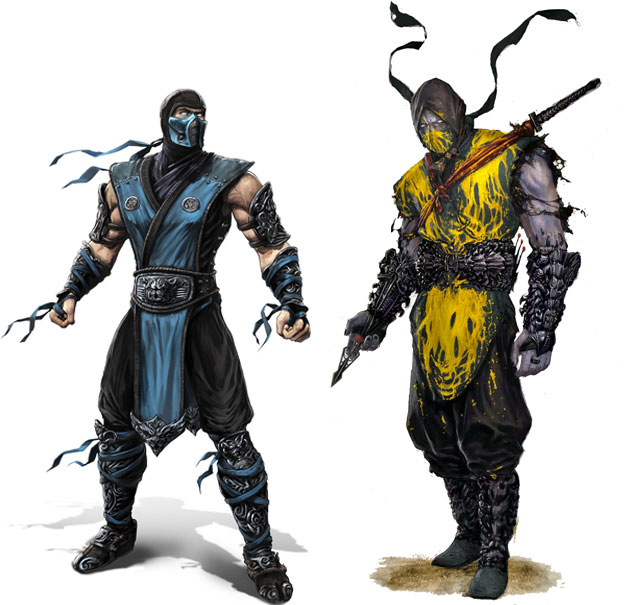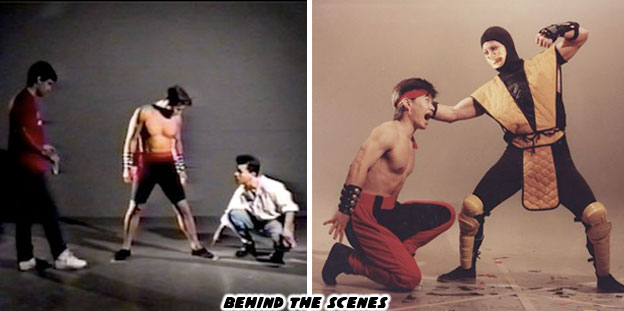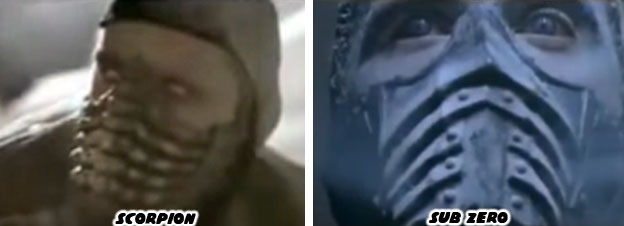Welcome back to the Street Writer Podcast, I'm your host Noe and we are talking about the greatest rivals in fighting game history. Today we look at one of the most fearsome and tragic figures in the genre. Hanzo Hayashi was an assassin that operated for the Shirai Ryu clan. He he had a wife but more important he had a fearsome reputation. He was known only as Scorpion to those that wanted to hire his services. There was another clan known as the Lin Kuei where Hanzo had a rival named Sub-Zero. The two knew of each other but never formally crossed paths. In ancient times a a sorcerer named Quan Chi hired both Scorpion and Sub-Zero to find a map hidden in the Himalayas. The reason he hired the two was to ensure that at least one of them could complete the mission. Quan Chi was trying to grow his magical powers and achieve immortality, the map was a key piece of the puzzle. Neither Scorpion nor Sub-Zero knew that their clan had been hired. Both followed their own leads and made their way through the Himalayas. Eventually the two crossed paths. You can imagine the amazing battle the two had. Both were excellent martial artists but Sub-Zero had the advantage. His tribe was descended from Cryomancers, these were sorcerers from another dimension known as the Outworld. In the Outworld sorcery rather than science reigned supreme. It was a barbaric place, filled with horrible monsters where only the most powerful warriors and magic users could thrive. There were connections between various dimensions and the Outworld, one of which lead to Earth. Several of the priests and monks from the Outworld had a hand in creating secretive martial arts schools in our world. Sub-Zero could freeze the air, ground and even opponents. He could also throw projectiles like frozen blades. Scorpion was limited by his traditional weaponry. Sub-Zero won the fight and decapitated his opponent. He later returned with the Lin Kuei clan and wiped out the Shirai Ryu, including Scorpion's wife. As the soul of Scorpion descended into the Netherrealm, the Outworld equivalent of Hell. He was offered a chance to return to Earth as a demon, but with little to no recollection of his previous life. He took this opportunity for revenge and became the fighting undead.

Sub-Zero had actually crossed paths with Scorpion while in the Netherrealm. He was sent by Raiden, the Thunder God, to retrieve an amulet from Quan Chi. Sub-Zero fought Scorpion in the hellish world and won a second time. He managed to escape the Netherrealm while Scorpion was down. Scorpion would not get his revenge until the end of the first Mortal Kombat tournament. The two did not fight in the actual tournament but after it had concluded. Scorpion with his newly formed demonic powers was more than a match for Sub-Zero. Scorpion could now summon roped daggers from his palm and throw them at his opponents. The trademark yell of "Got over here!" was born. He also gained the ability to teleport behind his opponent and beat them with a flurry of strikes. Behind his mask he was a skull set ablaze, on top of all his new powers he could also breathe fire. With these new attacks he killed Sub-Zero. As soon as his mission was complete he burst into flames and returned to the Netherrealm. He would be bound to wander that place for all time. It was a hollow victory because while he had avenged his wife and clan he would never be able to join them in the afterlife. This was some amazing storytelling and more important, it was the first memorable rivalry created by a Western-produced fighting game.
For the first few years of the '90s every arcade, corner liquor store and laundromat seemed to have a fighting game. The genre had blown wide open thanks to the success of Street Fighter II, Fatal Fury and the early pioneers. Audiences knew that the Japanese absolutely ruled the fighting game genre. No other developer could touch the nation when it came to graphics, control and gameplay. That perception changed very quickly in 1992 when US studio Midway released Mortal Kombat. This game looked and played unlike any other. First of all the graphics revolved around enormous sprites that were much larger and more detailed than the sprites used in other fighting games. The reason for this was because Midway was trying out some new technology for speeding up the game creation process. They would videotape and photograph actors in costumes. The artists would then create sprites out of these frames of data. This process was much faster than having to redraw sprites by hand. The studio could also focus resources more on control and gameplay because the graphics were taken care of. Midway did not really have much experience with fighting games but they did not simply want to poach the Capcom mechanics and risk a lawsuit. They used four main buttons for the attacks and a block button for defense. Data East would come along later and release Fighter's History which used Capcom's more familiar six-button layout. Capcom would take Data East to court but lose the case, opening the doors for other studios to copy the same control scheme as Street Fighter. But I digress... Midway managed to publish a fighting game that was fairly well balanced, offered some unique gameplay mechanics and introduced a bunch of new and hidden features. They did this in record time, just as the genre was taking off. Part of the success was thanks to their graphics process cutting down on development time. Updates to fix bugs could even get out to arcades faster than any other publisher. This was important because when the game came out it lacked the polish and ease of use of Street Fighter II but a few upgrades later it was suddenly very easy to get into.

Midway was sitting on a gold mine and at the heart of it were some violent characters. Players went crazy trying to figure out all of the Fatalities. Word spread quickly through the arcades when a new one was discovered. With each new secret uncovered there was a rush to the arcade to pump more quarters into the machines. No other studio had considered how important the replay value was when they released a fighting game. Adding hidden characters, secret moves, fatalities and levels kept people returning again and again. This raised the status of Midway and made the Japanese publishers take notice. The American studio was working around the clock to fill orders while the other publishers were cooling down sales. Suddenly every corner market, 7-11, Circle K and laundromat was coveting the fighting arcade machine as well. They did whatever it took to get one of the hot titles. It didn't matter whether they bought them from the publisher or got a bootleg from the black market. It was guaranteed money from a rapidly growing fan base. When it came to favorite titles fans were already picking sides. Every character in the Mortal Kombat franchise, even the hidden characters, had a following. Arguably the two biggest stars were Scorpion and Sub-Zero. They were perfect rivals. Midway could not have hoped for a better outcome to their design. The two had their own unique powers and abilities, each required their own technique to master. In any other fighting game people would have just thought of them as a pallet swap with some gimmick moves, but these two were different. They were living, breathing, fighters and not cartoons. The beef they had was tangible. If and when a movie came out then audiences knew exactly what they would look like and who they would root for. Speaking of which my younger brother and I won tickets to see the premier of the Mortal Kombat film in Los Angeles many years ago. We got a copy of the soundtrack and an autograph from Cary Tagawa, the actor that played Shang Tsung, he and his son snuck in to secretly watch the film.
Many fighting game fans in the USA, just like many fans in Japan, had grown up on martial arts movies. The kung-fu films from the Shaw Bros. and the indy films from Taiwan had circled the globe. They had cheesy effects, lousy scripts, were poorly dubbed and put on television in just about every market. Despite the quality of the films they were universally loved. The people creating the fighting games were just as familiar with these martial arts films as any fan. Street Fighter and the other games may have been inspired in part by the movies but Mortal Kombat was the first game that captured the spirit of those live action films. For the first time in the genre fans were not rooting for cartoon characters but real people. They were rooting for modern versions of those classic heroes and villains. Scorpion and Sub-Zero were created in a supporting role. Fighters like Liu Kang, Sonya Blade and Johhny Cage were the stars and Goro and Shang Tsung were the bad guys. Yet fans were very interested in the secretive ninjas, there was just something special about them. The anti-hero versus the cool villain, it wasn't as simple as good versus evil, both were killers. Both were two sides of the same coin. When audiences learned that the two hated each other they ate up the drama. What other fighting game character, or movie character for that reason, hated someone enough to return from Hell for a rematch?

Many of the elements, settings and characters in Mortal Kombat wouldn't have existed without kung-fu cinema. US audiences bought into the whole plot of the game. The game however could not have excited without the excessive violence from Western cinema as well. The game could never be violent or shocking enough for fans. It had to be brutal, it had to be bloody and there had to be a certain dark comedy element to it as well. Gen-Xers that made up a good portion of the arcade and console boom were starting to mature and they wanted to see more adult themes in their games. Scorpion and Sub-Zero were the R-Rated heroes in a previously PG crowd. They were not unlike Deadpool to the sanitized heroes in other Marvel movies. Speaking of comics a good portion of the design from Scorpion was also inspired by the Ghost Rider. The "Spirit of Vengeance" also had a flaming skull for a head and he threw a chain to snare opponents.
The purpose of Scorpion would evolve over the sequels. When he learned that Sub-Zero had returned for the second Mortal Kombat tournament he was furious. Death was not strong enough to keep his arch-rival at bay. Scorpion returned from the Netherrealm to enter the tournament as well. He eventually discovered that this was a different Sub-Zero, a younger brother who had the same cryomancer powers. Scorpion realized that he had no quarrel with the second Sub-Zero and let him be. The two would form a shaky alliance over different games and the truth would eventually be revealed. It was Quan Chi that orchestrated the murder of the Shirai Ryu clan and Scorpions wife. Quan Chi was teleported to the Netherrealm where Scorpion would spend eternity hunting down the powerful sorcerer. It was a fitting ending for one of the most violent fighting game characters invented. Audiences would never forget this warrior and the betrayal that created him. Not every rivalry in fighting games involved revenge. Some rivalries were created out of necessity. The last one I will feature for this series was simply destined to happen. Yet destiny has a long and winding road. I hope to see you back for that entry. As always if you would like to sponsor me please visit my Patreon page and consider donating each month, even as little as $1 would help make bigger and better recordings and videos.

No comments:
Post a Comment